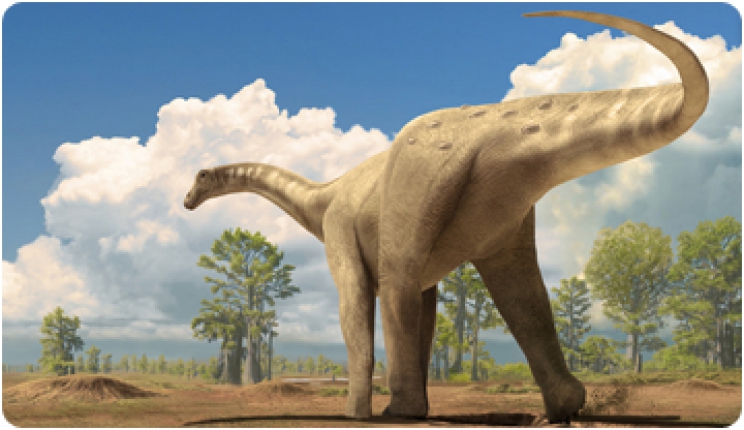
Reconstruction of a titanosaur in the Pyrenees 70 miliion years ago (Oscar Sanidisdro. ICP)
In this study led by Bernat Vila, associate researcher at the Institut Català de Paleontologia Miquel Crusafont (ICP), palaeontologists have compared a small trackway of a titanosaur sauropod from the Late Cretaceous with other specimens corresponding to larger ones in the same tracksite. The comparison of these trackways has helped to establish a cause-effect relationship between the gait, footprint size and body proportions of these sauropods.
Titanosaurs were a group of sauropod dinosaurs that had a characteristic arrangement of the femur and pelvic girdle that is reflected in the trackways that have been preserved in the fossil record. Their gait was wide and the footprints left by the legs in one side are quite separated from the other side.

Trackway of a titanosaur in Fumanya (Bernat Vila. ICP)
In the study published today in PLOS ONE, researchers of the ICP have compared trackways of specimens of different sizes and have demonstrated that they belonged to animals with many geometric similarities in body composition. From the observed amplitude between the legs either side of the tracks it can be deduced that they had similar body proportions, despite the large differences in body size. This led to the conclusion that the large and small titanosaurs moved in a dynamically similar way, probably using an ambling gait. This reinforces the hypothesis that titanosaurs had a unique set of anatomical features among sauropod dinosaurs.
Sauropod dinosaurs form the group of the largest terrestrial vertebrates that ever lived on land. They were herbivorous animals with a long tail and neck that allowed them to reach the higher vegetation. The titanosaurs that lived in Fumanya in Berguedà, could reach up to 15 meters in length and weigh up to 15 tons.
Fumanya, a unique dinosaur site
The Fumanya sites of Fígols and Vallcebre, were declared a Site of National Cultural Interest in 2005. The paleontological site includes the ancient open-cast coal mines in Fumanya Sud, Mina Esquirol, Fumanya Nord and Tumí. On the site, which covers an area of more than 38,000 square meters, more than 3000 dinosaur footprints have been have been found and fossil remains of eggs and bones have been identified, together with tree trunks and leaves from different types of palms. It is considered to be one of the most important sites in Europe for fossil remains of dinosaurs from the Late Cretaceous.
+ info: Bernat Vila, Oriol Oms, Àngel Galobart, Karl T. Bates, Victoria M. Egerton and Phillip L. Manning. “Dynamic similarity in titanosaur sauropods: ichnological evidence from the Fumanya dinosaur tracksite (southern Pyrenees)”. PLOS ONE http://dx.plos.org/10.1371/journal.pone.0057408 |











